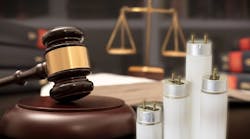Draft criteria for Energy Star integral LED lamps have been revised. The Department of Energy (DOE), Washington, D.C., published the first draft of these criteria Jan. 16, 2009, as the basis for initial review and dialogue with stakeholders. Comments on this second draft will be accepted through June 26, 2009. DOE anticipates publication of final criteria for integral LED lamps in August 2009. Feedback was provided by stakeholders, contributing to DOE’s proposed interim solutions described below.
1. Dimming
Stakeholder feedback acknowledged the complexity of the dimmer compatibility problem and cautioned that additional time, product development, and industry consensus on dimming protocols are needed to solve this problem over the long term.
DOE is engaging with the relevant industry standards committees (i.e., the NEMA Lighting Controls and Solid State Lighting Sections, and the ANSI 82.04 LED Drivers committee) and has hired an industry expert specifically to work with these committees and accelerate the development of industry consensus standards addressing this topic. This process is expected to proceed over the remainder of 2009 and into 2010.
DOE has revised the dimming requirements in the Draft 2 document to allow for dimmable (including continuous, 3-way, and other step dimming) and non-dimmable integral LED lamps to earn the Energy Star qualification. Manufacturers will be required to clearly label their lamps as dimmable or non-dimmable. Participating manufacturers must agree to maintain a Web page containing dimmer compatibility information for consumers, and to include a cautionary label on product packaging indicating potential compatibility limitations on existing dimmers and providing the dimmer page URL for up-to-date information.
2. Non-standard lamps
With regard to LED lamps in non-standard forms (shapes, sizes, and dimensions), Draft 1 established luminous efficacy (55 lm/W) and minimum light output (400 lumens) requirements for non-standard lamps; manufacturers were also required to provide a luminous intensity distribution (LM-79 goniophotometer report) for the lamp and to identify intended applications. In Draft 2, DOE has added a requirement for lamp packaging to include a simple graphic indicating beam shape. DOE invites stakeholder feedback on the proposal to develop or adapt a common set of beam graphics to be used by all Energy Star integral LED lamp partners. The luminous efficacy and minimum light output requirements remain unchanged in Draft 2.
3. Low-voltage MR16s
DOE sought industry and stakeholder input on how to address compatibility and minimum load problems for LED MR16 replacement lamps intended for use in existing low-voltage lighting systems/fixtures.
DOE proposes the following additional requirements for LED MR16 lamps intended for use on low-voltage fixtures in Draft 2:
- Manufacturers must provide results of in-house testing of their LED MR16 lamps on commercially available low-voltage transformers.
- Product packaging must identify known incompatibilities
- Manufacturer must maintain a Web page containing low-voltage transformer compatibility and appropriate use information, including description of possible problems and how to address them (“troubleshooting” advice).
- Product packaging must carry a cautionary label indicating the product may not be compatible with all low-voltage lighting fixtures and providing the Web page URL for up-to-date information.
- DOE invites additional stakeholder feedback on this approach and further information and suggestions for addressing low-voltage MR16 replacement lamp compatibility issues.
4. Reliability testing
DOE proposes a series of steps to evaluate lumen maintenance and reliability, and seeks additional stakeholder feedback and consensus on the items listed below.
With regard to lumen maintenance, DOE proposes a similar approach to that used in the Energy Star SSL luminaires program:
- Lumen maintenance (LM-80) test results for the LED packages, arrays, or modules used in lamp.
- Verification of the LED device or module temperature (at manufacturer-designated temperature measurement point or TMP) in the lamp through predrilled holes with thermocouples attached.
In addition, DOE is investigating the following reliability tests to be applied to the integral LED lamps as complete systems:
- Burn-in test (4 hr at 60°C) for all products before sale
- NEMA proposed to define a procedure
- Would eliminate from the sales stream those products likely to fail early
- Wet high-temperature operating life test (WHTOL)
- Ref std: EIA/JESD22-A101-B (Electronic Industries Alliance and JEDEC)
- Temperature, humidity, power cycling, and total test time to be determined
- Elevated temperature testing + rapid cycling stress testing
- Similar to testing to qualify reflector type CFLs in the Energy Star CFL program
Additional Changes between First and Second Drafts
1. Luminous efficacy.
In Draft 2, DOE has made several modifications to luminous efficacy levels. These revised efficacy levels remain at least as efficacious as CFLs for comparable power and light output. Differentiation of smaller form factor and/or lower-power lamps allows for earlier participation by Energy Star-qualified integral LED lamps in categories not currently well-served by CFL technology. Efficacy levels for LED directional lamps exceed CFL requirements. This is because the relatively high reflector losses inherent in CFL reflector lamps can be largely eliminated using LED technology.
2. CCT.
In Draft 2, DOE has added 4,000K to the allowable CCTs. This allows an additional option for applications in which a more neutral white color appearance is desired, such as in commercial settings. Draft 2 continues to exclude nominal CCTs above 4,000K, to help ensure end-user satisfaction with LED lamp color appearance.
3. Decorative lamps, minimum light output.
In Draft 2, the minimum light output requirement for decorative lamps has been changed to: Target lamp wattage × 7.


